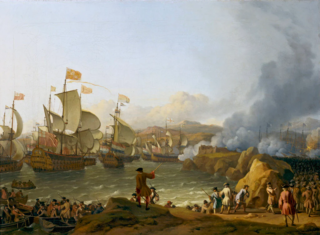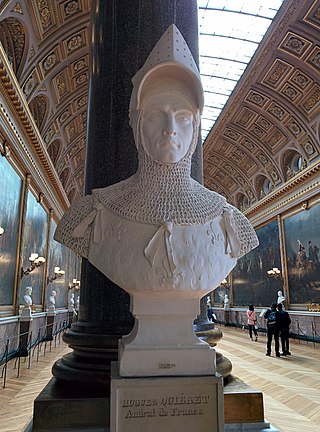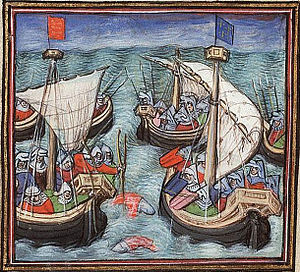
The Battle of Sluys, also called the Battle of l'Écluse, was a naval battle fought on 24 June 1340 between England and France. It took place in the roadstead of the port of Sluys, on a since silted-up inlet between Zeeland and West Flanders. The English fleet of 120–150 ships was led by Edward III of England and the 230-strong French fleet by the Breton knight Hugues Quiéret, Admiral of France, and Nicolas Béhuchet, Constable of France. The battle was one of the opening engagements of the Hundred Years' War.

51°15′N03°16′E

Arnemuiden is a city of around 5000 people in the municipality of Middelburg in the province of Zeeland in the Netherlands. It is located on the former island of Walcheren, about 3 km east of the city of Middelburg.

The Battle of Vigo Bay, also known as the Battle of Rande, was a naval engagement fought on 23 October 1702 during the opening years of the War of the Spanish Succession. The engagement followed an Anglo-Dutch attempt to capture the Spanish port of Cádiz in September in an effort to secure a naval base in the Iberian Peninsula. From this station the Allies had hoped to conduct operations in the western Mediterranean Sea, particularly against the French at Toulon. The amphibious assault, however, had proved a disaster, but as Admiral George Rooke retreated home in early October, he received news that the Spanish treasure fleet from America, laden with silver and merchandise, had entered Vigo Bay in northern Spain. Philips van Almonde convinced Rooke to attack the treasure ships, despite the lateness of the year and the fact that the vessels were protected by French ships-of-the-line.


The first phase of the Hundred Years' War between France and England lasted from 1337 to 1360. It is sometimes referred to as the Edwardian War because it was initiated by King Edward III of England, who claimed the French throne in defiance of King Philip VI of France. The dynastic conflict was caused by disputes over the French feudal sovereignty over Aquitaine and the English claims over the French royal title. The Kingdom of England and its allies dominated this phase of the war.

The Battle of Winchelsea or the Battle of Les Espagnols sur Mer was a naval battle that took place on 29 August 1350 as part of the Hundred Years' War between England and France. It was a victory for an English fleet of 50 ships, commanded by King Edward III, over a Castilian fleet of 47 larger vessels, commanded by Charles de la Cerda. Between 14 and 26 Castilian ships were captured, and several were sunk. Only two English vessels are known to have been sunk, but there was a significant loss of life.

The Battle of Cadzand was an early skirmish of the Hundred Years' War fought in 1337. It consisted of a raid on the Flemish island of Cadzand, designed to provoke a reaction and battle from the local garrison and so improve morale in England and amongst King Edward III's continental allies by providing his army with an easy victory. On 9 November Sir Walter Manny, with the advance troops for Edward III's continental invasion, made an attempt to take the city of Sluys, but was driven off.

The naval Battle of Saint-Mathieu took place on 10 August 1512 during the War of the League of Cambrai, near Brest, France, between an English fleet of 25 ships commanded by Sir Edward Howard and a Franco-Breton fleet of 22 ships commanded by René de Clermont. It is possibly the first battle between ships using cannon through ports, although this played a minor role in the fighting. This was one of only two full-fledged naval battles fought by King Henry VIII's Tudor navy, along with the later Battle of the Solent. During the battle, each navy's largest and most powerful ship — the Regent and the Marie-la-Cordelière – were destroyed in a large explosion aboard the latter.

The Spanish Armada was a Spanish fleet that sailed from Lisbon in late May 1588, commanded by the Duke of Medina Sidonia, an aristocrat without previous naval experience appointed by Philip II of Spain. His orders were to sail up the English Channel, join with the Duke of Parma in Flanders, and escort an invasion force that would land in England and overthrow Elizabeth I. Its purpose was to reinstate Catholicism in England, end support for the Dutch Republic, and prevent attacks by English and Dutch privateers against Spanish interests in the Americas.
The English Channel naval campaign of the years 1338 and 1339 saw a protracted series of raids conducted by the nascent French navy and numerous private raiders and pirates against English towns, shipping and islands in the English Channel, which caused widespread panic, damage and financial loss to the region and prompted a serious readjustment of English finances during the early stages of the Hundred Years' War. This period was then followed by a French disaster caused by over-confidence and a reversing of roles which had a major effect on the English successes of the next two decades; this result was by no means assured until late 1339 and had the French fought a little longer they might have ended the war before it had really begun.
The Battle of Sandwich, also called the Battle of Dover took place on 24 August 1217 as part of the First Barons' War. A Plantagenet English fleet commanded by Hubert de Burgh attacked a Capetian French fleet led by Eustace the Monk and Robert of Courtenay off Sandwich, Kent. The English captured the French flagship and most of the supply vessels, forcing the rest of the French fleet to return to Calais.

During the Dutch Revolt (1568–1648), the Dunkirkers or Dunkirk Privateers were commerce raiders in the service of the Spanish monarchy and later the Kingdom of France. They were also part of the Dunkirk fleet, which consequently was a part of the Spanish monarchy's Flemish fleet(Armada de Flandes). The Dunkirkers operated from the ports of the Flemish coast: Nieuwpoort, Ostend, and Dunkirk. Throughout the Eighty Years' War, the fleet of the Dutch Republic repeatedly tried to destroy the Dunkirkers. The first Dunkirkers sailed a group of warships outfitted by the Spanish government, but non-government investment in privateering soon led to a more numerous fleet of privately owned and outfitted warships.
The maritime history of England involves events including shipping, ports, navigation, and seamen, as well as marine sciences, exploration, trade, and maritime themes in the arts of England. Until the advent of air transport and the creation of the Channel Tunnel, marine transport was the only way of reaching the rest of Europe from England and for this reason, maritime trade and naval power have always had great importance. Prior to the Acts of Union in 1707, the maritime history of the British Isles was largely dominated by England.

Hugues Quiéret was a French nobleman, admiral and military commander. He was a knight, lord of Tours-en-Vimeu and of Hamicourt, both in Picardy. Before becoming an admiral, he was an advisor, Chamberlain, Grand Master of France, then the seneschal of Beaucaire and Nimes from 1325 to 1332.

Nicolas Béhuchet de Musy de La Loupe d'Escrignolles, also known as Colin Béhuchet, was a 14th century French admiral and financier. Together with Hugues Quiéret, he commanded the French fleet during the early phases of the Hundred Years' War. At the battle of Arnemuiden in 1338, Béhuchet ordered the English prisoners massacred. The following years, he and Quiéret fought the English in the Channel. Two years after Arnemuiden, the French fleet was anchored at Sluys in preparation of an invasion of England. The fleet was attacked by Edward III's English fleet and was destroyed in the battle of Sluys. After this defeat, the captured Béhuchet was hanged as a revenge for the massacre at Arnemuiden.

The battle of Zierikzee was a naval battle between a Flemish fleet and an allied Franco-Hollandic fleet which took place on 10 and 11 August 1304. The battle, fought near the town of Zierikzee, ended in a Franco-Dutch victory. The battle is part of a larger conflict between the Count of Flanders and his French feudal lord, King Philip IV of France (1296–1305).
The Truce of Espléchin (1340) was a truce between the English and French crowns during the early phases of the Hundred Years' War.
John Crabbe was a Flemish merchant, pirate and soldier who was active for around 35 years of his life. He defended Berwick Castle for the Scots against English forces in 1318, but after being captured by the English in 1332 he assisted the English when they again besieged Berwick in 1333, and became a loyal servant of Edward III, for whom he also fought at the Battle of Sluys in 1340.

The official history of the Royal Navy began with the establishment of the Navy Royal by Henry VIII in 1546. The modern incarnation of the institution re-emerged as the national naval force of the Kingdom of England in 1660, following the Restoration of King Charles II to the throne. However, for more than a thousand years before that there had been English naval forces varying in type and organisation. In 1707 it became the naval force of the Kingdom of Great Britain after the Union between England and Scotland which merged the English navy with the much smaller Royal Scots Navy, although the two had begun operating together from the time of the Union of the Crowns in 1603.














